Apple scrap vinegar, a wonderful way to create a no waste kitchen by using up all the scraps from fall’s most favorite apple recipes. Although not a true apple cider vinegar, this fermented apple scrap vinegar sure is a tasty alternative.
This post may contain affiliate links at no additional cost to you. By making your purchases through the links on this website, IMSL may make a small percentage at no direct cost to you. IMSL only promotes products we use & truly believe in. Please refer to my Privacy & Disclosures for further information. IMSL thanks you for your support!
Being New England born and raised the need to “waste not want not” is a deeply ingrained trait. This motto is never more blatantly apparent than when I see the mountains of apple cores and peels every fall produced from preparing & preserving our favorite apple sauce, apple crisp, and cider donuts that typically make it to the compost pile.
Being the frugal New Englander that I am, when I learned how to make a useful apple scrap vinegar from all those apple scraps, my little self did a happy dance 🤗
Again, this is not a “true” apple cider vinegar, but a wonderful addition to dressings, marinades, and infusing with your favorite herbs.
So what is the difference between apple cider vinegar and apple scrap vinegar? Read on, my friend.
APPLE SCRAP VINEGAR VS APPLE CIDER VINEGAR
Both sound pretty similar, right? To understand the differences between apple scrap vinegar vs apple cider vinegar, we must first understand what vinegar actually “is”.
A BRIEF LOOK INTO THE HISTORY OF VINEGAR
In my research of all things “vinegar”, y’all know how I love a good research project 😉 , I discovered a few tidbits of interesting info. Rather than recreating the wheel so to speak, this article on vinegar research says it all.
“Legend states that a courtier in Babylonia (c. 5000 BC) “discovered” wine, formed from unattended grape juice, leading to the eventual discovery of vinegar and its use as a food preservative. Hippocrates (c. 420 BC) used vinegar medicinally to manage wounds. Hannibal of Carthage (c. 200 BC), the great military leader and strategist, used vinegar to dissolve boulders that blocked his army’s path. Cleopatra (c. 50 BC) dissolved precious pearls in vinegar and offered her love potion to Anthony. Sung Tse, the 10th century creator of forensic medicine, advocated hand washing with sulfur and vinegar to avoid infection during autopsies. Based on the writings of US medical practitioners dating to the late 18th century, many ailments, from dropsy to poison ivy, croup, and stomachache, were treated with vinegar, and, before the production and marketing of hypoglycemic agents, vinegar “teas” were commonly consumed by diabetics to help manage their chronic ailment.”
NCBI
As most of you are aware, I am a huge fan of all things ACV, and use it regularly in my organic fire cider, elderberry syrup, bone broth, bbq sauce, and even in my homemade fly trap{s}! Needless to say, apple scrap vinegar would make a great substitution for ACV in any of these recipes!
ACV, apple cider vinegar, has long been used here on the hill in the kitchen. So what is the difference between the two?
THE DIFFERENCE BETWEEN APPLE CIDER VINEGAR & APPLE SCRAP VINEGAR
The difference between these two is simply “what” they are made from. ACV is made from, you got it, cider. Apple cider to be exact.
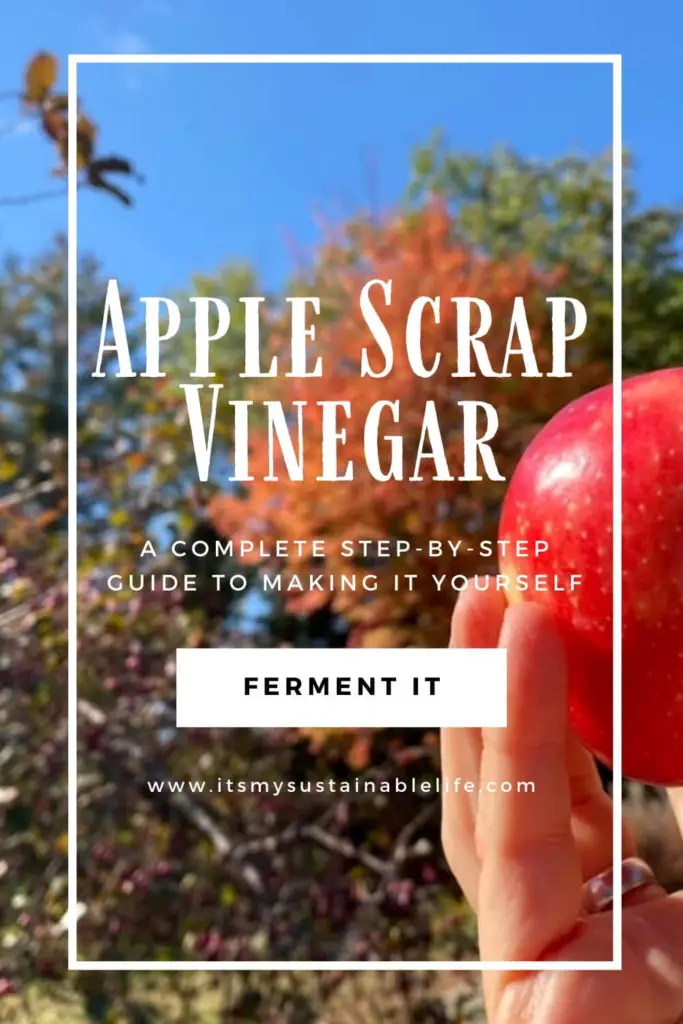
Apples are pressed to release their juices creating apple cider. This cider is then left to ferment first into hard cider & then continuing the fermentation process, resulting in the creation of apple cider vinegar. As we do not have a press at this time, we have not made cider from our apples here on the hill. There is a wonderful tutorial on how to make your own cider from the University of Georgia via the National Center For Home Food Preservation if you are interested.
Apple scrap vinegar, on the other hand, is made using the apple scraps. These apple scraps are then fermented using a bit of sugar, creating a milder & less acidic apple vinegar.
*NOTE: As apple scrap vinegar is less acidic (lower pH level) than traditional ACV, the homemade apple scrap vinegar should NOT be used for canning. You can review my safe canning tutorial for further information.
CAN YOU MAKE VINEGAR WITH APPLES & OTHER FRUITS
Absolutely! Vinegar can be created using just about any fruit,its peels and cores! Using the remnants of fruit, think strawberry, blueberry, cherry, raspberry, and blackberry here, a bit of water, sometimes a bit of added sugar, and the wonderful process of lacto-fermentation, a flavorful & unique vinegar can be created!

If you are unfamiliar with lacto-fermentation process, take a quick look at what the process is & why it’s so good for us here. While your there, be sure to check out my other fermented recipes for yogurt,and kombucha!
As an Amazon Associate, I earn from qualifying purchases at no additional cost to you.
Want to really get the scoop on all things fermented? I highly recommend “The Noma Guide To Fermentation” by Noma’s owners & chefs René Redzepi and David Zilber.
APPLE SCRAP VINEGAR WITH MOTHER
Utilizing all the beneficial qualites of ACV with a mother has long been touted here on the hill. When making my own apple scrap vinegar, figuring out how I can create this vinegar and develop its own beneficial mother was at the top of my list.
Anytime I ferment, I hope and pray that the ferment captures all the beneficial cultures present in the air itself and create a “mother”. Often, this is a big ‘ole crap shoot, however.
Then it dawned on me. I have the mother of all mother’s when it comes to fermenting…a kombucha scoby. What would happen if I placed a slice of the scoby along with my scraps?
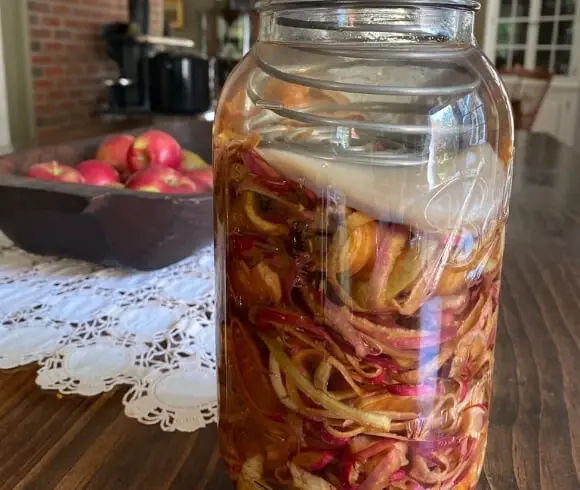
Thinking this was such a unique and bright idea I had, like everything, I researched. Low and behold, I am not the first with this awesome idea 😊
Once my ferment has completed in a few weeks time, I will update this tutorial with my experimental results!
UPDATE: This experiment worked wonderfully! Once made, a new “mother” easily grew. When making new batches I add a new “mother” along with some starter ferment to get the batch going well!
PROVEN BENEFITS OF APPLE CIDER & APPLE SCRAP VINEGAR
So here I am ranting and going on about all the benefits of using ACV and apple scrap vinegar. But exactly what are the benefits?
Although the internet would have us believing that ACV is the next coming of “you know who”, and can treat & cure just about any ailment under the sun, unfortunately, there is not a lot of substantiated research in this area.
That doesn’t mean, however, that it doesn’t have it’s merits. Here are a few…
- Assists with blood sugar control
- Aids in controling bacteria on foods
- May aid weight loss
- Has shown improvement in heart health in animals
HOW TO MAKE APPLE SCRAP VINEGAR
Now to the easy part. Making the apple scrap vinegar. Taking these simple ingredients, apple scraps, water, glass jar, fermenting weight either purchased or created (see more about alternatives below), and a bit of sugar, it’s just a matter of time before you can enjoy your end product….vinegar.
As an Amazon Associate, I earn from qualifying purchases at no additional cost to you.
As you will be utilizing everything leftover from your apples, it is important that you choose your apples wisely. This means, organic if you can source them, & washed thoroughly.
NOTE: When choosing apples, why not consider the ugly fruit? You know, the ones that are mis-shaped, have spots on them, and generally don’t look as apetizing to eat fresh. The beauty of the ugly fruit is they taste just as good, and what better way to utilize them than with making apple scrap vinegar?
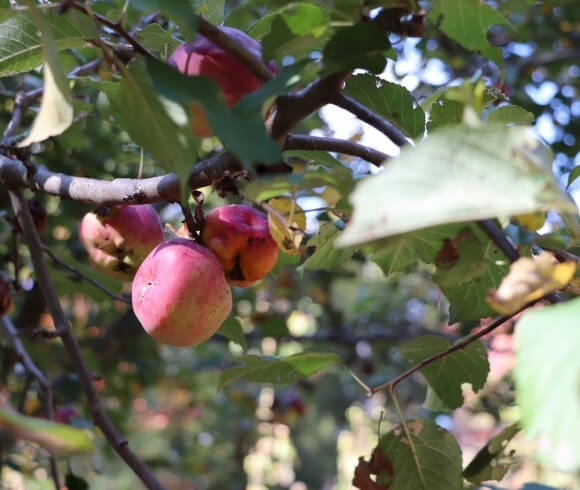
- Using a large glass jar, I like to use a half gallon mason jar for this purpose, take your apple scraps, peels & core alike and place into the jar. Packing them into the jar, leaving 1-2 inch headspace at the top.
- If you will be adding a splash (1-2 Tbl) of ACV with mother, or a piece of Kombucha scoby, do so now, placing it on top of the scraps.
- In warm unchlorinated water, dissolve 1-2 Tbl of sugar. Pour the sugar water into the jar. Cover the scraps with pure, unchlorinated water, leaving 1-2 inches of headspace.
As an Amazon Associate, I earn from qualifying purchases at no additional cost to you.
- Either using a fermenting weight or the helix coil from my favorite fermenting kit to hold the scraps down, cover the jar making sure all the scraps and scoby remain submerged. If using the fermenting kit, do NOT utilize the lock screw on lid. As most fermenting water lock and other systems are made to keep the acetic acid bacteria out of the ferment, when making vinegar it’s the acetic acid bacteria we want. Utilizing a simple cloth covering works just fine.
NOTE: The Trellis Fermenting Kit has been used continually here on the hill for the last 2 years, and is one product that I can highly recommend. By ordering from the link(s) provided, I do receive a small affiliate percentage at no additional cost to you, which in turn supports IMSL.
- Be sure to not invite unwanted guests, aka, fruit flies into your kitchen and cover the jar loosely with a towel or cloth napkin secured with a rubber band. You can thank me later 😉
Now all you need to do is give it time. After about one week you should start to see bubbles beginning to form around the apples and on top of the water. The concoction should have a sweet, apple smelling scent at this point. You can stir the apples if you like, but I prefer to leave it to do it’s thing. Converting sugars into alcohol and carbon dioxide.
The vinegar is ready to strain typically within a few weeks time. Should any scum appear on the top of the ferment simply skim it off.
At this point, your “vinegar” should smell a bit sweet. Kind of, well, like apples 😊
Don’t throw away those discarded scraps! They make a wonderful treat for your chickens or your compost!
To reach the “vinegar” stage, simply place your strained liquid in a dark cabinet and let it set for another 2-4 weeks time.
The longer it sets, the stronger the flavor. It’s all a matter of preference.
TIPS & SUGGESTIONS FOR MAKING APPLE SCRAP VINEGAR
If you are anything like myself, it takes a few experiments & failures before reaching success. Fermenting is no different. I have a few suggestions to help increase the likelihood of success when making your apple scrap vinegar.
1. Start With Clean Everything
When it comes to fermenting vinegar from fruit scraps, cleanliness matters. Start the process with clean, well, everything. Utensils, tools, jars, bowls, and kitchen. Although we are looking to attract the acetic acid bacteria, other forms of bacteria can be harmful to the ferment and cause failure.
As an Amazon Associate, I earn from qualifying purchases at no additional cost to you.
2. Choose Your Container Wisely
Stay clear of utilizing metal other than stainless steel when fermenting. Some believe it can taint the end product, making it unuseable. True? Not sure. By why take the chance? Choose glass jars and wooden utensils to be on the safe side.
3. Water Matters
The source of your water matters when fermenting. Chlorinated water can kill the exact bacteria we are trying to lure into our ferment. If your water is chlorinated you have a few choices.
- Filter it with a quality water filtration system like this one from Berkey
- Neutralize the chlorine with the use of Vitamin C
- Use distilled or bottled water
4. Don’t Skip The Sugar
This is one time you don’t want to skip the sugar. It is a minimal amount in comparison to the quantity of the ferment and is a necessary ingredient for the fermenting process.
It’s the sugar that feeds the beneficial bacteria & yeasts needed to create the ferment. By the end of the process, there will be little to no sugar left in the vinegar.
This is one time where sugar is a must for creating a successful ferment. Can you use honey? Yes, but know that it can prolong the fermenting process as it’s a more complex sugar for the bacteria to digest.
5. Expect Some Browning To Occur
Over time (about one week into the process for me) the bits & scraps of apples will begin to brown, turning the fluid to a light brown vinegar color. This is totally normal & to be expected.
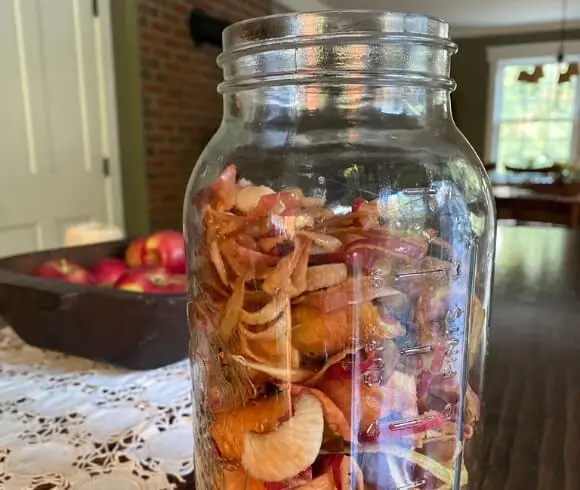
6. Know When You’ve Created The “Mother”
You will know you’ve been successful in creating a “mother” if when you uncover your jar you see a gooey looking glob of who knows what floating on the top of the liquid. Congrats!! This is what most vinegar fermenters are looking for!
As you continue to make your apple scrap vinegar, many will remove and store the mother along with a bit of starter vinegar for jump starting your next brew. I find it easier to leave it in the vinegar jar itself and transfer when making a new batch.
You do, however, want to make sure periodically that this is the only thing you are brewing 😉 Should you also find mold beginning to develop, simply skim it off and discard. Typically mold can develop when you attempt your ferment without the use of a fermentation weight to hold the solids under the liquid or forego the sugar.
7. Creative Fermentation Weights
Choosing to use a fermentation weight of some sort is a must when fermenting. Although the small investment in a fermentation kit like the Trellis Fermentation Kit I use is a wise investment if you are planning to continue fermenting, it is not absolutely necessary.
Anything with a little weight (other than metal) can be used to hold the solids under the fluid. Plastic items or baggies (plastic erodes when in contact with ferments, especially vinegar, and may leach unwanted chemicals into the product), rocks that you’ve boiled unless you know exactly what the rock is comprised of, and household knick-knacks are NOT recommended as they may contain unwanted & possibly dangerous components.
Think foods like cabbage cores, sliced apples layed horizontally on the top would work great in this case, and even daikon radish layed on the top of the solids will aid in keeping all submerged.
Nesting a smaller mason jar or glass on top may work as well. Get creative, or like me, just invest in a kit 🙂
Making apple scrap vinegar is a soul satisfying project, especially for a frugal New Englander like myself 😉
Have you made apple scrap vinegar or fruit scrap vinegar?
Love, Light, & Laughter ~

As an Amazon Associate, I earn from qualifying purchases at no additional cost to you.
DISCLAIMER
Recommendations and or suggestions made by this blog regarding husbandry and or herbal remedies etc. are not meant to replace solid advice from qualified professionals. None of the information on this blog has been evaluated by the FDA. Products or remedies mentioned are not intended to diagnose, treat, cure or prevent disease. Please do your due diligence. Research, talk to qualified professionals and proceed at your own risk.

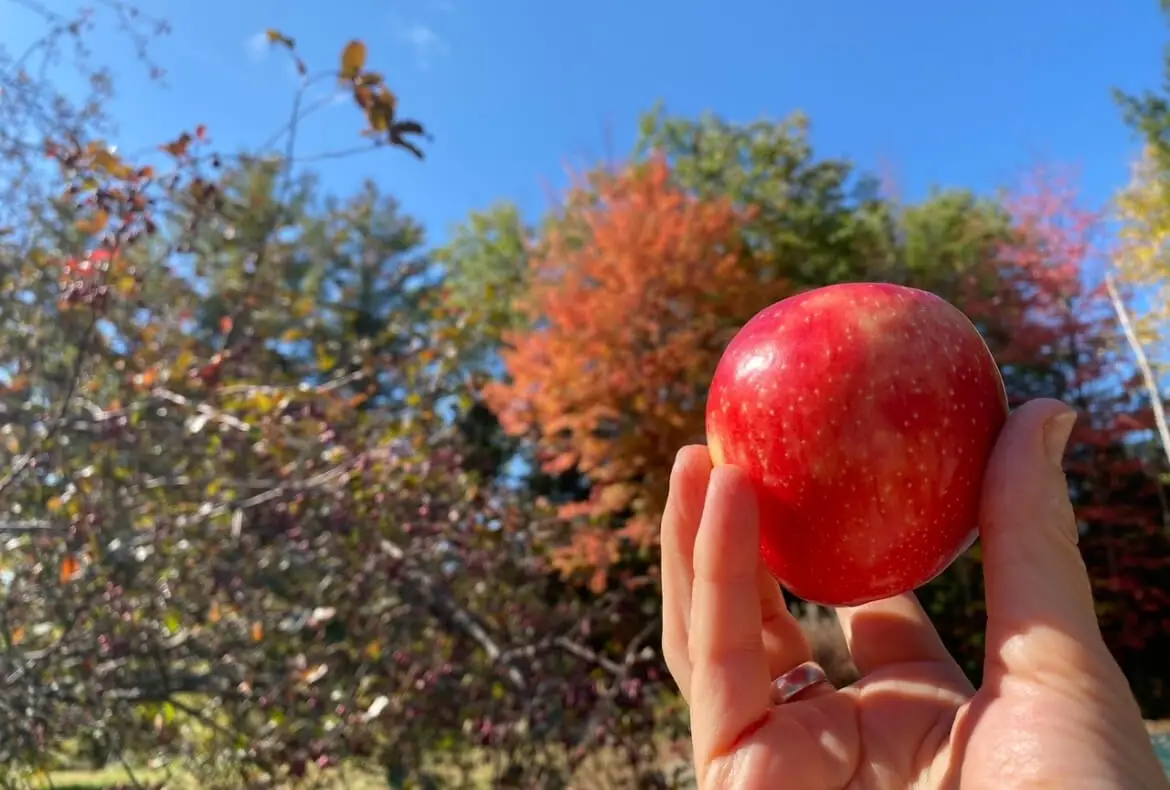
38 comments
I enjoyed learning about the history of vinegar. Great idea to make vinegar from all those gorgeous apple peels?
Happy Fall,
Kippi
Oh my! I never knew one could make this! Is there a difference in taste between the two? Where do you store the vinegar during the process of making it? Thank you for this information!
Hello!
Yes, there is a slight difference in taste. The homemade, in my opinion is not quite as tangy as the purchased, but close enough that I don’t mind it. The longer you let it set, however, the tangier it becomes. And it’s FREE! I’ve left my jar on my kitchen counter covered with a clean cloth with no issue.
Thank you for stopping by. I hope you can give it a try!
Suzan
Thanks for sharing with us at Farm Fresh Tuesdays Blog Hop! Your Apple Scrap Vinegar is one of my features at this week’s hop. Be sure to stop by to see your feature and say hi! See you there!
Melissa | Little Frugal Homestead
Such an informative post. Thank you!
This looks interesting. I think I’ll give it a try.
I’m going to try this! Thanks for the instructions and inspiration.
We never knew that you could make this! We learn so much from you! Thank you for sharing.
So interesting! Never thought that fruit scraps could be made into vinegar! Very frugal!! 👍🏻👍🏻
I just love this! We have an apple tree and we have been making lots of apple butter. We have just been throwing the scraps to the chickens, but I think I need to try this! Thank you for sharing at Embracing Home and Family!
I knew some information but, I love learning all this new information. Thank You for the artical.
I never have heard of this! We just visited the orchard so this looks something we could take a go at. Thanks for sharing.
I’d love to try this, only apples are quite expensive at this time of year in the part of India I live in. Bookmarking for later in the year, not that there’s too much of the year left! 😉
I’m visiting from the Inspire Me Monday link up over at Janice’s blog.
Hi Corinne~
Thank you for visiting all the way from India! If apples are not available right now, you could certainly make this from other fruit scraps as well! Hope you enjoy it as much as I do!
Love your frugality, using every bit. The book you mentioned – is that from the noma restaurant in Copenhagen? It’s been listed as the Beat Restaurant in the World 8 of the last 10 years (something like that), and after eating nearby last spring, I had reservations this year (cancelled, of course 🙄). You have to book it 6-12 months in advance. I’ll get there someday! The foodie scene in Copenhagen is outstanding.
Yes, it is! What a wonderful experience that will be for you!
That’s no anything I would have ever thought of ! Thanks for the info!
I’ve never heard of this before, but it looks like a great way to use my apple scraps. Thanks for sharing!
I always learn so much from your content. Thank you for all of your informative and interesting articles.
Thank you for your kind words, Candy! I’m so glad you are finding the content interesting!
What a fun project! My kids and I love acv in our water, tea, salads and more. I can’t wait to try making our own!
Great recipe. I love apple cider vinegar and use it everyday in my tea. Thanks for sharing.
This is such a creative idea! I too am a waste not want not kind of person!
We just went apple picking yesterday – this post is going to be so beneficial for us and our scraps!
This is fantastic! I love different vinegars and especially those with health benefits, I am going to make this and use it in my coleslaw recipe… it sounds delicious!
This is super interesting! I love that history bit on vinegar. And what a great way to use scraps, I will have to do this!
I think it is so fun to learn how to do this at home. I recently purchased this at the store!
I shared this with my mom! Looking forward to trying it!!
Wow! 😁 I don’t know how soon I will be making apple scrap vinegar for my household, as we don’t eat many apples at home, but I loved reading the short history of vinegar! Now I understand why ACV is promoted for weight loss. 👍🏻
What a great use of apple scraps!
I bet this is more tolerable than apple cider vinegar and it sounds very good for you! Thank you for this
This is a neat idea! I actually love the way it looks in the jar, the colors are pretty! I love that you can use the scraps and have less waste!
What a great idea! We just went apple picking and have been making all kinds of things, so I have LOTS of apple scraps! I think I’ll try it with pear scraps too!
Wonderful! Be sure & let me know how the pear vinegar turns out!
Thanks for the tips. I’ll give it a try!
Fascinating! We love AVC so I can’t wait to try this. Thanks for the history and science lesson all in one!
Ooooh I am absolutely doing this! How fun. I love to taste different vinegars so will be anxious. Pinning and forwarding on to folks that I think would enjoy it! Thanks.
Hope you enjoy it as much as I do Beth! Thank you for reading!